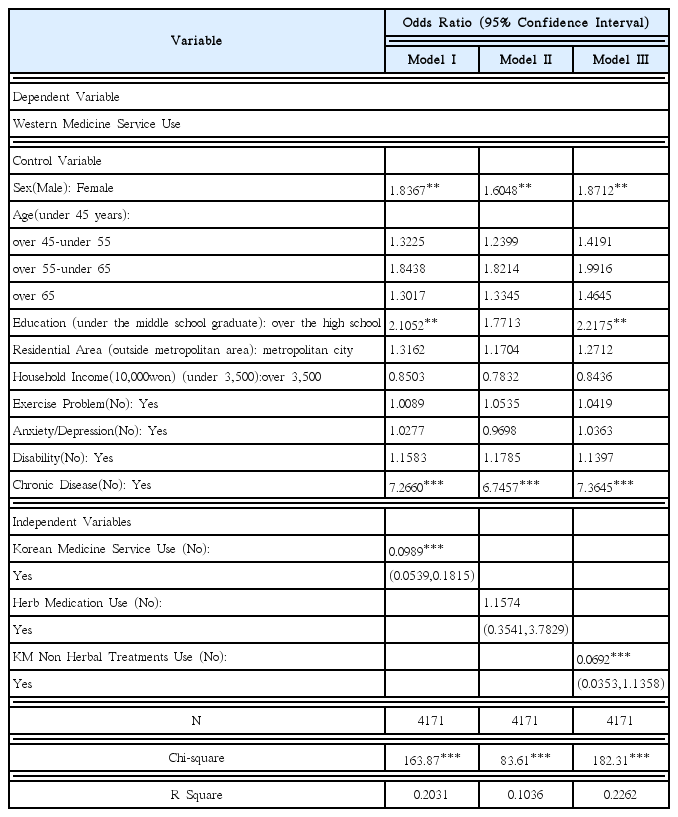References
1. Health Insurance Review & Assessment Service. 2012 Health Insurance Statistics. Health Insurance Review & Assessment Service 2012;359:606.
2. Jacobs JJ, Andersson GJ, Bell JE, Weinstien SL, Gnatz SM, Dormans JP, et al. The Burden of Musculoskeletal Diseases. Bone and joint decade 2011. 1.
3. Jung G, Kim JH. Comparison of Conventional Medicines and Complementary- Alternative Therapy Utilization on Musculoskeletal Pain. Health and Social Welfare Review 2011;31(4):478–493.
4. Kim SY, Park JY. The Utilization of Western and Oriental Medical Services by Outpatients with Musculoskeletal System Disorders and Its Related Factors. The Korean Journal of Health Service Management 2012;6(1):27–38.
5. Andersen RM, Aday LA. Access to medical care in the US : realized and potential. Medical Care 1978;16(7):533–546.
6. Seo NG, An SJ, Hwang YH, Kang TW, Choi JS, Jung YH, et al. 2013;Korean Health Panel In-depth Analysis Report. Korea Institute for Health and Social Affairs·National Health Insurance 2013;13
7. Kim YA. The Comparison of Outpatient Clinic Use Factors, Medical Expenses and QOL with Western Medicine and Western·Korean Medicine. In : 4th Korean Health Panel Conference; 2012; p. 227–238.
8. Oh IH, Yun SJ. The Analysis of Korean and Western Medical Use Ratio according to the Disease Using Korean Health Panel Data. In : 3th Korean Health Panel Conference; 2013; p. 165–176.
9. Park MJ. The Research about Socioeconomical Dicision Factor of Korean Medicine Outpatients Clinic Use. In : 4th Korean Health Panel Conference; 2012; p. 213–225.
10. Yoo WK. A Study on Recognition Level of the People on Oriental Medical Services and the Need for its Improvement. Korean Journal of Oriental Preventive Medical Society 2003;7(2):45–64.
11. Choi BH, Kim DS, Yoo WK, Yun YJ, Kwon YK, Lim BM, et al. Identifying Complementary and Substitute Relationships between Korean Medicine and Western Medicine using Korea Health Panel dataset. Korean Journal of Oriental Preventive Medical Society 2013;17(3):1–18.
12. Paramore LC. Use of alternative therapies : estimates from the 1994 Robert Wood Johnson Foundation National Access to Care Survey. Journal of Pain and Symptom. Management 1997;13(2):83–89.
13. Eisenberg DM, Davis RB, Ettner SL, Appel S, Wilkey S, Kessler RC, et al. Trends in alternative medicine use in the United States, 1990–1997: results of a follow-up national survey. JAMA 1998;280(18):1569–1575.
14. Kim NK, Yang BM, Lee TJ, Kwon SM. An economic analysis of usual care and acupuncture collaborative treatment on chronic low back pain: a Markov model decision analysis. BMC Complement Altern Med 2010;25:10–74.
10.1186/1472-6882-10-74.
15. Trinh KV, Graham N, Gross AR, Goldsmith CH, Wang E, Cameron ID, et al. Acupuncture for neck disorders. Cochrane Database Systematic review. 2006. 3CD004870.
16. Furlan AD, van Tulder M, Cherkin D, Tsukayama H, Lao L, Berman B, et al. Acupuncture and dry-needling for low back pain: an updated systematic review within the framework of the Cochrane collaboration. Spine 2005;30:944–63.
17. Witt C, Brinkhaus B, Jena S, Streng A, Wagenpfeil S, Hummelsberger J, et al. Acupuncture in patients with osteoarthritis of the knee: a randomised trial. Lancet 2005;366:136–43.
18. Casimiro L, Barnsley L, Brosseau L, Milne S, Robinson VA, Tugwell P, et al. Acupuncture and electroacupuncture for the treatment of rheumatoid arthritis (review). Cochrane Database Systematic review 2005. 4CD003788.
19. Xu KT, Farrell TW. The Complementary and Substitution between Unconventional and Mainstream Medicine among Racial and Ethnic Groups in the United States. Health Services Research 2006;42(2):811–826.




